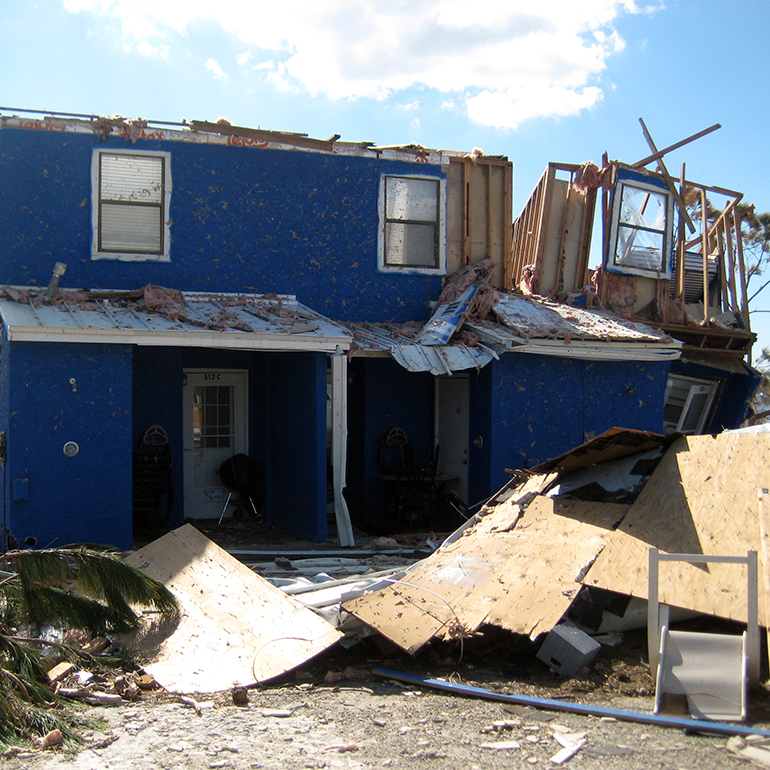The best way to protect your home during a powerful storm is through home hardening. Hardening fortifies your home, strengthening it against the worst kinds of damage.
Why should I think about fortifying my home?
Hurricane winds can cause tremendous property loss, but a large amount of damage is actually caused by wind-borne debris such as tree limbs, street signs, roof tiles, etc., and not the wind itself. Non-impact resistant windows and doors can fail during a storm when debris penetrates them, allowing wind to enter a home. This creates rapid internal pressurization, or significantly more pressure inside the house than the structure is designed to withstand. Seeking another way out, the pressure often results in lifting the roof or pushing out the walls, leaving your home uninhabitable. When an opening is breached, internal pressures are substantially increased. This is why it’s important to fortify or harden your entire home. 
Home Hardening Tips
PGT Innovations specializes in impact-resistant doors and windows, which can protect your home from major damage. We offer these home hardening tips to help keep your home secure.
Passive vs. Active Protection
There are two primary types of protective materials for your home:
- Passive protection does not require you to take any immediate action right before a storm.
Examples: Installing impact-resistant windows and doors; tying your roof down in advance. - Active hardening requires immediate action before a storm hits.
Examples: Putting plywood or shutters on your windows as a storm approaches; hiring a contractor to inspect your home before the start of the hurricane season.
Vulnerable Home Entry Points
- Roof. During a windstorm, the force of the wind pushes against the outside of your home, which is passed along from the roof to the exterior walls, and finally to the foundation. The end wall of a home with a gabled roof takes a beating during a hurricane, and those that are not properly braced can collapse, causing major damage to the roof.
- Windows. If windows are damaged during a storm, high winds and debris can enter and put pressure on the roof and walls, causing potential damage.
- Doors. Don’t forget about sliding glass doors and garage doors — ensure that they are properly sealed and maintained. Your garage door is one of the likeliest components of your home to give in to high winds.
Top 3 Investments
- Impact-resistant windows and entry doors increase your family’s safety and eliminate the need to spend money and time on purchasing and installing plywood and shutters.
- Professionally installed roof tie-downs anchor the roof to the foundation of the house, keeping it securely in place.
- Wind-rated and impact-rated garage doors are designed to protect one of your home’s largest openings.
Tasks Often Overlooked
- At the beginning of hurricane season, inspect windows and doors for cracks in the seals. Hire a professional to help fix any voids.
- Make sure all windows and entry points are locked to help keep them securely closed at all times during a storm.
- Place all moveable objects inside, including garbage cans, planters, outdoor furniture, and vehicles.
- Cover all landscaping pebbles and rocks to prevent them from flying during high winds.
Are My Windows/Doors Impact Resistant?
It’s not always easy to determine, but here are a few indicators:
- Look for a Gold Label, which is a permanent label on the framing that identifies who certified it. Codes to look for:
- TAS 201/203
- ASTM E1886/1996
- AAMA 506
- See if you find a laser-etched logo in the corner of the glass. Be careful, as this doesn’t necessarily mean the windows are impact-resistant, but it can be an indication.
- If you don’t see a label, we recommend calling the manufacturer.
If You Already Have Impact-Resistant Windows
- Impact-resistant windows are designed to last for 20 years.
- Having impact-resistant windows does not mean you don’t need to tie down your roof.
- Call your installer to ensure that your windows are up to code.
Shutters and Plywood
Homeowners often choose to depend on shutters or plywood panels to protect their homes. But be cautious, as these can have drawbacks:
- Plywood installation is the most economical way to protect home windows from a major storm, but the plywood must be code-approved and requires specific anchorage to ensure that it will remain securely attached to the home.
- Installation of plywood can take several hours, and may require specialty equipment and people to install it.
- If your home loses power, plywood or shutters can provide outside light from entering while making the home uncomfortably warm.
- Shutters and plywood can create hazards:
- Shutters or plywood panels must be installed properly, or they could become dangerously loose.
- It’s challenging to exit or enter a home if shutters and plywood are installed.
- If shutters and plywood are not removed immediately after a storm, residents may be at risk of being trapped inside if a fire breaks out.
WATCH: The Importance of Home Hardening by PGT Innovations President & CEO Jeff Jackson
Click here for our storm readiness page that has information on how you can prepare for a storm and learn more about hurricane protection.
 Click here to download our hurricane resource guide for keeping yourself, your loved ones, and your property safe throughout this year’s hurricane season.
Click here to download our hurricane resource guide for keeping yourself, your loved ones, and your property safe throughout this year’s hurricane season.

